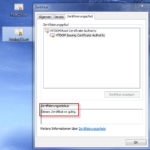In diesen Beitrag möchte ich kurz zeigen, wie man sich für eine Testumgebung oder vielleicht einen späteren Live Betrieb eine zweistufige PKI mit OpenSSL einrichtet.
Hierzu wurde ein Standard Ubuntu 16.04 LTS Server installiert.
Das wichtigste für eine CA ist die OpenSSL-Konfigurationsdatei, diese liegt Standardmäßig jeder openssl Installation bei, diese Datei wurde kopiert und auf die Testumgebung angepasst.
Wenn Ihr andere Installationspfade nutzen wollt, dann bitte dementsprechend die ca-config.cnf Datei nach euren Bedürfnisse anpassen.
|
1 2 3 |
locate *.cnf /etc/ssl/openssl.cnf /usr/lib/ssl/openssl.cnf |
Was sehr wichtig ist, sind die Sektionen. Die URLs müssen unbedingt für die Testumgebung angepasst werden. Damit im Zertifikat später die richtigen URLs stehen.
Die Certification Revocation List (*.crl) muss über http:// erreichbar sein, wenn das nicht der Fall ist, kann es zu unnötigen Fehlern kommen.
|
1 2 3 4 5 6 7 8 9 10 |
[root_ca] [issuingca_cert] [user_cert] [server_cert] authorityInfoAccess = caIssuers;URI:http://server.domain.de/RootCA.html crlDistributionPoints=URI:http://server.domain.de/RootCA.crl authorityInfoAccess = caIssuers;URI:http://server.domain.de/IssuingCA.html crlDistributionPoints=URI:http://server.domain.de/IssuingCA.crl |
ca-config.cnf
|
1 2 3 4 5 6 7 8 9 10 11 12 13 14 15 16 17 18 19 20 21 22 23 24 25 26 27 28 29 30 31 32 33 34 35 36 37 38 39 40 41 42 43 44 45 46 47 48 49 50 51 52 53 54 55 56 57 58 59 60 61 62 63 64 65 66 67 68 69 70 71 72 73 74 75 76 77 78 79 80 81 82 83 84 85 86 87 88 89 90 91 92 93 94 95 96 97 98 99 100 101 102 103 104 105 106 107 108 109 110 111 112 113 114 115 116 117 118 119 120 121 122 123 124 125 126 127 128 129 130 131 132 133 134 135 136 137 138 139 140 141 142 143 144 145 146 147 148 149 150 151 152 153 154 155 156 157 158 159 160 161 162 163 164 165 166 167 168 169 170 171 172 173 174 175 176 177 178 179 180 181 182 183 184 185 186 187 188 189 190 191 192 193 194 195 196 197 198 199 200 201 202 203 204 205 206 207 208 209 210 211 212 213 214 215 216 217 218 219 220 221 |
# This definition stops the following lines choking if HOME isn't # defined. HOME = . RANDFILE = $ENV::HOME/.rnd # Extra OBJECT IDENTIFIER info: oid_section = new_oids [new_oids] # Policies used by the TSA examples. tsa_policy1 = 1.2.3.4.1 tsa_policy2 = 1.2.3.4.5.6 tsa_policy3 = 1.2.3.4.5.7 #################################################################### [ca] default_ca = RootCA # The default ca section #################################################################### [RootCA] dir = /opt/ca/RootCA # Where everything is kept certs = $dir/certs # Where the issued certs are kept crl_dir = $dir/crl # Where the issued crl are kept database = $dir/index.txt # database index file. new_certs_dir = $dir/newcerts # default place for new certs. certificate = $dir/RootCA.crt # The CA certificate serial = $dir/serial # The current serial number crlnumber = $dir/crlnumber # the current crl number # must be commented out to leave a V1 CRL crl = $crl_dir/RootCA.crl # The current CRL private_key = $dir/private/RootCA.key # The private key RANDFILE = $dir/private/.randRootCA # private random number file x509_extensions = user_cert # The extentions to add to the cert name_opt = ca_default # Subject Name options cert_opt = ca_default # Certificate field options default_days = 3650 # how long to certify for default_crl_days = 30 # how long before next CRL default_md = sha512 # use public key default MD preserve = no # keep passed DN ordering policy = policy_anything # CHANGE THIS #################################################################### [IssuingCA] dir = /opt/ca/IssuingCA # Where everything is kept certs = $dir/certs # Where the issued certs are kept crl_dir = $dir/crl # Where the issued crl are kept database = $dir/index.txt # database index file. new_certs_dir = $dir/newcerts # default place for new certs. certificate = $dir/IssuingCA.crt # The CA certificate serial = $dir/serial # The current serial number crlnumber = $dir/crlnumber # the current crl number # must be commented out to leave a V1 CRL crl = $crl_dir/IssuingCA.crl # The current CRL private_key = $dir/private/IssuingCA.key # The private key RANDFILE = $dir/private/.randIssuingCA # private random number file x509_extensions = user_cert # The extentions to add to the cert name_opt = ca_default # Subject Name options cert_opt = ca_default # Certificate field options default_days = 3650 # how long to certify for default_crl_days = 30 # how long before next CRL default_md = sha512 # use public key default MD preserve = no # keep passed DN ordering policy = policy_match #################################################################### [policy_match] countryName = match stateOrProvinceName = match organizationName = match organizationalUnitName = optional commonName = supplied emailAddress = optional #################################################################### [policy_anything] countryName = optional stateOrProvinceName = optional localityName = optional organizationName = optional organizationalUnitName = optional commonName = supplied emailAddress = optional #################################################################### [req] default_bits = 2048 default_keyfile = privkey.pem distinguished_name = req_distinguished_name attributes = req_attributes x509_extensions = root_ca string_mask = utf8only #################################################################### [req_distinguished_name] countryName = Country Name (2 letter code) countryName_default = DE countryName_min = 2 countryName_max = 2 stateOrProvinceName = State or Province Name (Bayern) stateOrProvinceName_default = Bayern localityName = Locality Name (Muenchen) localityName_default = Muenchen 0.organizationName = Organization Name (Company name or your Name) 0.organizationName_default = HTDOM Company GmbH organizationalUnitName = Organizational Unit Name (Department) organizationalUnitName_default = IT commonName = Common Name (Server FQDN or your Name) commonName_max = 64 emailAddress = Email Address emailAddress_max = 64 #################################################################### [req_attributes] challengePassword = A challenge password challengePassword_min = 4 challengePassword_max = 20 unstructuredName = An optional company name #################################################################### [v3_req] # Extensions to add to a certificate request basicConstraints = CA:FALSE keyUsage = nonRepudiation, digitalSignature, keyEncipherment ## Key Usage (Schlüsselverwendung) # decipherOnly: Ist keyAgreement gesetzt, darf der Public-Key innerhalb eines Schlüsselaustausche zur Entschlüsselung von Daten verwendet werden. Andernfalls undefiniert. # encipherOnly: Ist keyAgreement gesetzt, darf der Public-Key innerhalb eines Schlüselaustausches zur Verschlüsselung von Daten verwendet werden. Andernfalls undefiniert. # cRLSign: Public-Key kann verwendet werden, um CRLs zu verifizieren. # keysCertSign: Public-Key kann verwendet werden, um Zertifikate zu verifizieren. # keyAgreement: Zur Verwendung beim Schlüsselaustausch. # dataEncipherment: Zur Verwendung von „normalen“ Daten, also kein Schlüsseln. # keyEncipherment: Public-Key wird zum Schlüsselmanagement verwendet. # nonRepudiation: Key zur Prüfung von „bewußten“ Signaturen (außer CRLs und bei Zertifikaten). # digitalSignature: Key zur Prüfung von „automatischen“ Signaturen (außer CRLs und bei Zertifikaten). ## keyUsage = [critical,] [decipherOnly,] [encipherOnly,] [cRLSign,] [keysCertSign,] [keyAgreement,] [dataEncipherment,] [keyEncipherment,] [nonRepudiation,] [digitalSignature] ## Extended Key Usage (Erweiterte Schlüsselverwendung) # serverAuth: Authentisierung von Web-Servern durch Web-Clients # clientAuth: Authentisierung von Web-Clients durch Web-Server # codeSigning: Key zur Signierung von Programm-Code # emailProtection: Key zur Verwendung mit S/MIME-Software # timStamping: Signierung von Objekt-Hashwerten und zugehörigen vertrauenswürdigen Zeitstempeln ## Microsoft-Extensions # msCodeInd: Individual Code Signing # msCodeCom: Commercial Code Signing # msCTLSign: Trust List Sign # msSGC: Server-Zertifikat mit „Global Server ID“ # msEFS: Verschlüsselung von symmetrischen Keys zur Dateisystem-Verschlüselung ## Netscape-Extensions # nsSGC: Server-Zertifikat mit "Global Server ID" ## keyUsage = [critical,] [serverAuth,] [clientAuth,] [codeSigning,] [emailProtection,] [timeStamping,] [msCodeInd,] [msCodeCom,] [msCTLSign,] [msSGC,] [msEFS,] [nsSGC,] [OID] # [v3_req] # Extensions to add to a certificate request # basicConstraints = CA:FALSE # keyUsage = nonRepudiation, digitalSignature, keyEncipherment # subjectAltName = @alt_names # [alt_names] # DNS.1 = servername.domain.de # DNS.2 = servername # DNS.3 = # IP.1 = 192.168.xxx.yyy # IP.2 = 192.168.yyy.zzz # IP.3 = #################################################################### [root_ca] subjectKeyIdentifier=hash authorityKeyIdentifier=keyid:always,issuer basicConstraints = critical, CA:true, pathlen:1 keyUsage = cRLSign, keyCertSign subjectAltName=email:copy # URI of the CA certificate authorityInfoAccess = caIssuers;URI:http://server.domain.de/RootCA.html crlDistributionPoints=URI:http://server.domain.de/RootCA.crl #################################################################### [issuingca_cert] subjectKeyIdentifier=hash authorityKeyIdentifier=keyid:always,issuer basicConstraints = critical, CA:true, pathlen:0 keyUsage = cRLSign, keyCertSign subjectAltName=email:copy # URI of the CA certificate authorityInfoAccess = caIssuers;URI:http://server.domain.de/IssuingCA.html crlDistributionPoints=URI:http://server.domain.de/IssuingCA.crl #################################################################### [user_cert] basicConstraints=CA:FALSE keyUsage = nonRepudiation, digitalSignature, keyEncipherment subjectKeyIdentifier=hash authorityKeyIdentifier=keyid,issuer subjectAltName=email:copy extendedKeyUsage = clientAuth, emailProtection, codeSigning # URI of the CA certificate authorityInfoAccess = caIssuers;URI:http://server.domain.de/IssuingCA.html crlDistributionPoints=URI:http://server.domain.de/IssuingCA.crl #################################################################### [server_cert] basicConstraints=CA:FALSE keyUsage = nonRepudiation, digitalSignature, keyEncipherment, dataEncipherment extendedKeyUsage = serverAuth # URI of the CA certificate authorityInfoAccess = caIssuers;URI:http://server.domain.de/IssuingCA.html crlDistributionPoints=URI:http://server.domain.de/IssuingCA.crl #################################################################### [crl_ext] authorityKeyIdentifier=keyid:always #################################################################### |
Root Certificate Authority einrichten
|
1 2 3 4 5 6 7 8 9 10 11 12 13 14 15 16 17 18 19 20 21 22 23 24 25 26 27 28 29 30 31 32 33 34 35 36 37 38 39 40 41 42 |
## Ordnerstruktur für die RootCA anlegen ## mkdir -p /opt/ca/RootCA cd /opt/ca/RootCA # certs - werden kopien der ausgestellten Zertifikate gespeichert # crl - wird eine kopie aller erstellen CRL’s gespeichert # newcerts - wird eine kopie aller Zertifikats Requeste gespeichert # private - Wird der private Schlüssel der Zertifizierungsstelle gespeichert # revoke - hierhin werden alle gesperrten Zertifikate verschoben mkdir certs crl newcerts private revoke touch index.txt echo "01" > serial echo "01" > crlnumber chmod 0600 private/ ## Hier wird ein Random Nummer für die spätere Schlüsselerstellung generiert ## openssl rand -out private/.randRootCA 8192 chmod 0400 private/.randRootCA ## Privaten Key für RootCA erstellen ## openssl genrsa -aes256 -out private/RootCA.key 4096 -rand private/.randRootCA 2 x Passphrase eingeben (Hier sollte in einer Live Umgebung ein sehr komplexes Kennwort von min. 15-20 Stellen verwendet werden) chmod 0400 private/RootCA.key ## Erstelle das Selbssignierte RootCA Zertifikat ## openssl req -new -x509 -days 3650 -sha512 -key private/RootCA.key -out RootCA.crt -config ca-config.cnf 2 x Passphrase eingeben Country Name (2 letter code) [DE]:DE State or Province Name (Bayern) [Some-State]:Bayern Locality Name (eg, Muenchen) []:Muenchen Organization Name (eg, company) [Example Organisation]:HTDOM Company GmbH Organizational Unit Name (eg, section) []:IT-Security Common Name (e.g. server FQDN or YOUR name) []:HTDOM Root Certificate Authority Email Address []: |
Issuing Certificate Authority einrichten
|
1 2 3 4 5 6 7 8 9 10 11 12 13 14 15 16 17 18 19 20 21 22 23 24 25 26 27 28 29 30 31 32 33 34 35 36 37 38 39 40 41 42 43 44 45 46 47 48 |
## Ordnerstruktur für die IssuingCA anlegen ## mkdir /opt/ca/IssuingCA cd /opt/ca/IssuingCA cp /opt/ca/RootCA/ca-config.cnf . # certs - werden kopien der ausgestellten Zertifikate gespeichert # crl - wird eine kopie aller erstellen CRL’s gespeichert # newcerts - wird eine kopie aller Zertifikat Requeste gespeichert # private - wird der private Schlüssel der Zertifizierungsstelle gespeichert # revoke - hier werden alle gesperrten zertifikate verschoben mkdir certs crl newcerts private revoke touch index.txt echo "01" > serial echo "01" > crlnumber chmod 0600 private/ ## Hier wird ein Random Nummer für die spätere Schlüsselerstellung generiert ## openssl rand -out private/.randIssuingCA 8192 chmod 0400 private/.randIssuingCA ## Privaten Key für IssuingCA erstellen ## openssl genrsa -aes256 -out private/IssuingCA.key 4096 -rand private/.randIssuingCA 2 x Passphrase eingeben (Hier sollte in einer Live Umgebung ein sehr komplexes Kennwort von min. 15-20 Stellen verwendet werden) chmod 0400 private/IssuingCA.key ## Ertselle einen Zertifikat Request, der von der RootCA signiert wird. ## openssl req -new -key private/IssuingCA.key -out newcerts/IssuingCA-Request.csr -config ca-config.cnf 2 x Passphrase eingeben Country Name (2 letter code) [DE]:DE State or Province Name (Bayern) [Some-State]:Bayern Locality Name (eg, Muenchen) []:Muenchen Organization Name (eg, company) [Example Organisation]:HTDOM Company GmbH Organizational Unit Name (eg, section) []:IT-Security Common Name (e.g. server FQDN or YOUR name) []:HTDOM Issuing Certificate Authority Email Address []: Please enter the following 'extra' attributes to be sent with your certificate request A challenge password []: An optional company name []: |
Issuing Certificate Request genemigen
|
1 2 3 4 5 6 7 8 9 10 11 12 13 14 15 16 17 18 19 20 21 22 23 24 25 26 27 28 29 30 31 32 33 34 35 36 37 38 39 40 41 42 43 44 45 46 47 48 49 50 |
cd /opt/ca/RootCA ## Zertifikats Request der IssuingCA bei der RootCA signieren ## openssl ca -name RootCA -in /opt/ca/IssuingCA/newcerts/IssuingCA-Request.csr -out /opt/ca/RootCA/certs/IssuingCA.crt -extensions issuingca_cert -config ca-config.cnf Using configuration from ca-config.cnf Enter pass phrase for /opt/ca/RootCA/private/RootCA.key: Check that the request matches the signature Signature ok Certificate Details: Serial Number: 1 (0x1) Validity Not Before: Sep 19 20:19:10 2016 GMT Not After : Sep 17 20:19:10 2026 GMT Subject: countryName = DE stateOrProvinceName = Bayern localityName = Muenchen organizationName = HTDOM Company GmbH organizationalUnitName = IT-Security commonName = HTDOM Issuing Certificate Authority emailAddress = X509v3 extensions: X509v3 Subject Key Identifier: 98:D9:DE:BB:D1:27:44:51:B3:F0:07:BD:95:59:39:3A:24:14:10:29 X509v3 Authority Key Identifier: keyid:7A:D8:D3:65:45:3F:C6:FF:7D:91:1F:15:53:6D:F8:0D:BA:E7:E3:8F X509v3 Basic Constraints: critical CA:TRUE, pathlen:0 X509v3 Key Usage: Certificate Sign, CRL Sign X509v3 Subject Alternative Name: email: Authority Information Access: CA Issuers - URI:http://server.domain.de/RootCA.html X509v3 CRL Distribution Points: Full Name: URI:http://server.domain.de/RootCA.crl Certificate is to be certified until Sep 17 20:19:10 2026 GMT (3650 days) Sign the certificate? [y/n]:y 1 out of 1 certificate requests certified, commit? [y/n]y Write out database with 1 new entries Data Base Updated |
Webserver Zertifikat erstellen
|
1 2 3 4 5 6 7 8 9 10 11 12 13 14 15 16 17 18 19 20 21 22 23 24 25 26 27 28 29 30 31 32 33 34 35 36 37 38 39 40 41 42 43 44 45 46 47 |
cd /opt/ca/IssuingCA openssl genrsa -aes256 -out private/webserver01_htdom_local.key 2048 -rand private/.randIssuingCA chmod 0400 private/webserver01_htdom_local.key openssl req -new -key private/webserver01_htdom_local.key -out newcerts/webserver01_htdom_local.csr -config ca-config.cnf openssl ca -name IssuingCA -in newcerts/webserver01_htdom_local.csr -out certs/webserver01_htdom_local.crt -extensions server_cert -config ca-config.cnf Using configuration from ca-config.cnf Enter pass phrase for /opt/ca/IssuingCA/private/IssuingCA.key: Check that the request matches the signature Signature ok Certificate Details: Serial Number: 1 (0x1) Validity Not Before: Sep 19 20:54:03 2016 GMT Not After : Sep 17 20:54:03 2026 GMT Subject: countryName = DE stateOrProvinceName = Bayern organizationName = HTDOM Company GmbH organizationalUnitName = IT-Support commonName = webserver01.htdom.local emailAddress = X509v3 extensions: X509v3 Basic Constraints: CA:FALSE X509v3 Key Usage: Digital Signature, Non Repudiation, Key Encipherment, Data Encipherment X509v3 Extended Key Usage: TLS Web Server Authentication Authority Information Access: CA Issuers - URI:http://server.domain.de/RootCA.html X509v3 CRL Distribution Points: Full Name: URI:http://server.domain.de/RootCA.crl Certificate is to be certified until Sep 17 20:54:03 2026 GMT (3650 days) Sign the certificate? [y/n]:y 1 out of 1 certificate requests certified, commit? [y/n]y Write out database with 1 new entries Data Base Updated |
Certification Revocation List erstellen
|
1 2 3 4 5 6 7 |
## Unabhängig ob gesperrte Zertifikate existieren oder nicht sollte eine Sperrliste für das Root/Issuing Zertifikat erstellt werden ## cd /opt/ca/RootCA openssl ca -config ca-config.cnf -gencrl -out RootCA.crl cd /opt/ca/IssuingCA openssl ca -config ca-config.cnf -gencrl -out IssuingCA.crl |
Zertifikate wiederrufen
|
1 2 3 4 |
## Wird ein Zertifikat gesperrt, so ist die Sperrung in index.txt einzutragen ## cd /opt/ca/IssuingCA openssl ca -config ca-config.cnf -revoke certs/webserver01_htdom_local.crt |
Nützliche Befehle
|
1 2 3 4 5 6 7 8 9 10 11 12 13 14 15 16 17 18 19 20 21 22 23 24 25 26 27 28 29 30 31 32 33 34 35 36 37 38 39 40 41 42 43 44 45 46 47 48 49 50 51 52 53 54 55 56 57 58 59 60 61 62 63 64 65 |
## Zertifikate und Private Keys überprüfen ## ## In diesen Beispiel wir der Private Key überprüft ob dieser mit dem Zertifikat zusammenpasst ## In dem Abschnitt modules, sieht man den Privaten Key ## openssl x509 -noout -text -in /opt/ca/RootCA/RootCA.crt | less openssl rsa -noout -text -in /opt/ca/RootCA/private/RootCA.key | less Passphrase modulus: 00:ce:50:8a:8d:5e:8b:8d:47:38:b4:b0:25:d2:57: ... 1b:56:ff Modulus: 00:ce:50:8a:8d:5e:8b:8d:47:38:b4:b0:25:d2:57: ... 1b:56:ff openssl x509 -noout -text -in /opt/ca/IssuingCA/IssuingCA.crt | less openssl rsa -noout -text -in /opt/ca/IssuingCA/private/IssuingCA.key | less Passphrase ## Zertifikatsrequest überprüfen, ob alle Angaben passen. ## openssl req -noout -text -in /opt/ca/IssuingCA/newcerts/IssuingCA-Request.csr | less ## RootCA und IssuingCA Zertifikat überprüfen ## openssl verify -CAfile /opt/ca/RootCA/RootCA.crt /opt/ca/IssuingCA/IssuingCA.crt /opt/ca/IssuingCA/IssuingCA.crt: OK ## Zertifikat Chain aus RootCA und IssuingCA bilden ## cat /opt/ca/IssuingCA/IssuingCA.crt /opt/ca/RootCA/RootCA.crt > /opt/ca/IssuingCA/HTDOM_IssuingCA_Chain.crt chmod 444 /opt/ca/IssuingCA/HTDOM_IssuingCA_Chain.crt ## RootCA Zertifikat auf Windows Rechner downloaden und installieren ## cat /opt/ca/RootCA/RootCA.crt | sed -n -e '/BEGIN\ CERTIFICATE/,/END\ CERTIFICATE/ p' -----BEGIN CERTIFICATE----- MIIGlzCCBH+gAwIBAgIJAMEh+l6C/y+PMA0GCSqGSIb3DQEBDQUAMIGPMQswCQYD ... GPKo9XOLXNQhcWvo9J4cekWimz8z1Aj1YkEFkwKopY0+549r1W+H+OnZ1u0d77Zt iw4t1xMigeji4qU= -----END CERTIFICATE----- ## Zertifikat Chain auf Windows Rechner downloaden und installieren ## cat /opt/ca/IssuingCA/HTDOM_IssuingCA_Chain.crt | sed -n -e '/BEGIN\ CERTIFICATE/,/END\ CERTIFICATE/ p' -----BEGIN CERTIFICATE----- MIIGmDCCBICgAwIBAgIBATANBgkqhkiG9w0BAQ0FADCBjzELMAkGA1UEBhMCREUx ... Jt3lzRluOVcEZY4m -----END CERTIFICATE----- -----BEGIN CERTIFICATE----- MIIGlzCCBH+gAwIBAgIJAMEh+l6C/y+PMA0GCSqGSIb3DQEBDQUAMIGPMQswCQYD ... iw4t1xMigeji4qU= -----END CERTIFICATE----- |
Da kein Computer dieser Welt unsere CA kennt, müssen wir natürlich das Root CA Zertifikat und Issuing CA Zertifikat auf jeden Computer installieren.
Dazu lege ich mir eine RootCA.txt und eine IssuingCA.txt Datei lokal auf dem Computer an und hole mir wie oben beschrieben die Zertifikatsinformationen.
Wenn beide Text Dateien gefüllt sind, werden dies in *.crt umbenannt, danach installiere ich diese unter Windows in den passenden Zertifikatsspeicher.
Das RootCA Zertifikat wird in den „Vertrauenswürdige Stammzertifizierungsstelle“ installiert.
Und das Issuing CA Zertifikat wird unter „Zwischenzertifizierungsstelle“ installiert.
Wenn beide Zertifikate sauber installiert wurde, kann man sich das Zertifikat ansehen, in dem das man es doppelklickt und sich alle Informationen ansieht.
Unter Linux ist das ganze ein bisschen einfacher, hierzu kopiert man beide Zertifikate in den Zertifikatsspeicher und lässt ein Update laufen, danach sind dem Linux Server/Client die Zertifikate bekannt.
|
1 2 3 4 5 6 7 8 9 10 11 12 13 |
cp /opt/ca/RootCA/RootCA.crt /usr/local/share/ca-certificates/ cp /opt/ca/IssuingCA/HTDOM_IssuingCA_Chain.crt /usr/local/share/ca-certificates/ update-ca-certificates Updating certificates in /etc/ssl/certs... 2 added, 0 removed; done. Running hooks in /etc/ca-certificates/update.d... done. ls -la /etc/ssl/certs/RootCA* lrwxrwxrwx 1 root root 43 Jan 22 12:57 /etc/ssl/certs/RootCA.pem -> /usr/local/share/ca-certificates/RootCA.crt ls -la /etc/ssl/certs/HTDOM_IssuingCA_Chain.pem lrwxrwxrwx 1 root root 58 Jan 22 12:57 /etc/ssl/certs/HTDOM_IssuingCA_Chain.pem -> /usr/local/share/ca-certificates/HTDOM_IssuingCA_Chain.crt |
So nun viel Spaß beim ausprobieren.
Viele Grüße
Helmut



